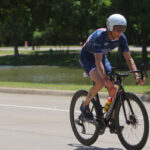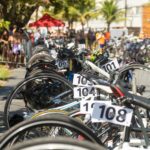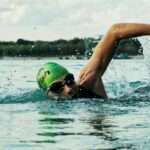Triathlon imagery is perhaps the most powerful mental skill you can develop to help you achieve Prime Triathlon. There are four factors that will impact the quality of your triathlon imagery: perspective, control, multiple sense, and speed. You can develop each of these areas so you can get the most out of your triathlon imagery.
Imagery Perspective
Imagery perspective refers to where the “imagery camera” is when you do triathlon imagery. The internal perspective involves seeing yourself from inside your body looking out, as if you were actually performing. The imagery camera is inside your head looking out through your eyes. The external perspective involves seeing yourself from outside your body like on video. The imagery camera follows you from the outside. Research indicates that one perspective is not better than the other. Most people have a dominant perspective with which they’re most comfortable. You should use the perspective that’s most natural for you and then experiment with the other perspective to see if it helps you in a different way.
Control
Have you ever been doing triathlon imagery and you keep making mistakes, for example, while imagining yourself swimming, the water feels thick like molasses or while imagining yourself running, your feet stick to the road? This problem relates to imagery control, which is how well you’re able to imagine what you want to imagine. It’s not uncommon for triathletes to perform poorly in their imagery. If bad images occur in your imagery, you shouldn’t just let them go by. If you do, you’ll ingrain the negative image and feeling which will hurt your confidence. Instead, when you perform poorly in your imagery, immediately rewind the “imagery video” and edit it and rerun the imagery video until you see yourself performing well.
Multiple Senses
Good triathlon imagery is more than just visual. The best imagery involves the multi-sensory reproduction of the actual triathlon experience. You should duplicate the sights, sounds, physical sensations, thoughts, and emotions that you would experience in an actual triathlon. Visual imagery involves how clearly you see yourself performing, for instance, seeing yourself having a fast transition. Vivid auditory images are important because sounds can play an important part in triathlon, for example, the sound of your breathing during the run. The most powerful part of triathlon imagery is feeling it in your body. That’s how you really ingrain new skills and habits. To improve the feeling of your imagery, focus on the movement of your muscles as you imagine yourself in each leg of a triathlon.
Speed
The ability to adjust the speed of your imagery will enable you to use triathlon imagery to improve different aspects of your performances. Slow motion is effective for focusing on technique. When you first start to work on technique in your imagery, slow the imagery video down, frame by frame if necessary, to see yourself executing the skills correctly. Then, as you see and feel yourself performing well in slow motion, increase the speed of your imagery until you can perform well at “real-time” speed.






